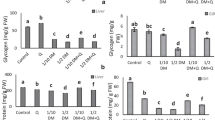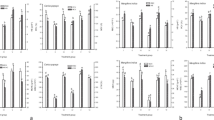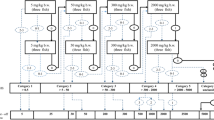Abstract
Atrazine (ATZ) is one of the pesticides mostly widely used in Brazil; several studies have shown the toxic effects of this herbicide on aquatic organisms such as fish. Thus, it is absolutely necessary finding alternatives to protect the health of fish, mainly of species commercially important for aquaculture, which may be exposed to atrazine deriving from agricultural runoff. The aim of the current study was to investigate interactions between dietary supplementation with vitamin C (Vit C) antioxidant and exposure to ATZ in Rhamdia quelen fish exposed to this herbicide. R. quelen specimens were divided into four groups: (1) CTRL, (2) VitC, (3) ATZ, (4) ATZ + VitC. Groups 3 and 4 were exposed to ATZ (10 µg L−1) for 96 h, after 30 days of VitC supplementation (1 g kg−1). Liver samples were collected for biomarker assays. Group 4 was the only group presenting decreased protein carbonyl content. Non-protein thiol (NPSH) levels were significantly higher in groups VitC, ATZ and ATZ + VitC than in CTRL. Group ATZ + VitC presented significant increase in glutatione-peroxidase (GPx) activity in comparison to the other investigated groups. Ascorbic acid (AA) levels were significantly higher in group VitC and lower in group ATZ. Therefore, interactions between herbicide ATZ and dietary supplementation with Vit C have shown biochemical changes in R. quelen fish. Thus, dietary supplements with adequate amounts of Vit C can be added as antioxidants to the diet of fish bred in aquaculture systems in order to protect them from exposure to ATZ.


Similar content being viewed by others
Data Availability
Not applicable.
Code Availability
Not applicable.
References
Abraham P (2005) Vitamin C may be beneficial in the prevention of paracetamol-induced renal damage. Clin Exp Nephrol 9:24–30
Aebi H (1984) Catalase in vitro. Methods Enzymol 105:121–126
Borges A, Scotti LV, Siqueira DR, Zanini R, Do Amaral F, Jurinitz DF, Wassermann GF (2007) Changes in hematological and serum biochemical values in jundiá Rhamdia quelen due to sub-lethal toxicity of cypermethrin. Chemosphere 69:920–926
Bradford MM (1976) A rapid and sensitive method for the quantitation of microgram quantities of protein utilizing the principle of protein-dye binding. Anal Biochem 72:248–254
Buege JA, Aust SD (1978) Microssomal lipid peroxidation. Methods Enzymol 52:302–309
Comber SDW (1999) Abiotic persistence of atrazine and simazine in water. Pestic Sci 55:696–702
Cunha MA, Zeppenfeld CC, Garcia LO, Loro VL, Fonseca MB, Emanuelli T, Veeck APL, Copatti CE, Baldisserotto B (2010) Anesthesia of silver catfish with eugenol: time of induction, cortisol response and sensory analysis of fillet. Cienc Rural 40(10):2107–2114
Dayanand CD, Vegi PK, Kutty AV (2012) Protein carbonyl content as a stable oxidative stress marker in Type II diabetes. Int J Biol Med Res 3(4):2362–2365
De Andrade LL, do Espirito Santo PA, Fernandes FL, Martinez CBDR (2019) Can atrazine loaded nanocapsules reduce the toxic effects of this herbicide on the fish Prochilodus lineatus? A multibiomarker approach. Sci Total Environ 663:548–559
Diniz NM, Honorato CA (2012) Algumas alternativas para diminuir os efeitos do estresse em peixes de cultivo - revisão. Arq Ciênc Vet Zool UNIPAR 15(2):149–154
Donato FF, Martins ML, Munaretto JS, Prestes OD, Adaime MB, Zanella R (2015) Development of a multiresidue method for pesticide analysis in drinking water by solid phase extraction and determination by gas and liquid chromatography with triple quadruple tandem mass spectrometry. J Braz Chem Soc 26(10):2077–2087
Ellman GL (1959) Tissue sulfhydryl groups. Arch Biochem Biophys 82:70–77
Ferreira D, Da Motta AC, Kreutz LC, Toni C, Loro VL, Barcellos LJG (2010) Assessment of oxidative stress in Rhamdia quelen exposed to agrichemicals. Chemosphere 79:914–921
Foyer CH, Noctor G (2011) Ascorbate and glutathione: the heart of the redox hub. Plant Physiol 155:2–18
Fukushima H, Bailone RL, Weiss LA, Martins ML, Zaniboni-Filho E (2012) Triploidy in the hematology of jundia juveniles (Siluriformes: Heptapteridae). Braz J Biol 72(1):147–151
Gao J, Koshio S, Ishikawa M, Yokoyama S, Nguyen BT, Mamauag RE (2012) Effect of dietary oxidized fish oil and vitamin C supplementation on growth performance and reduction of oxidative stress in Red Sea Bream Pagrus major. Aquac Nutr 19(1):35–44
Huergo GM, Zaniboni-Filho E (2006) Triploidy induction in Jundiá, Rhamdia quelen, through hydrostatic pressure shock. J Appl Aquac 18:45–57
Marins AT, Rodrigues CCR, De Menezes CC, Gomes JDLC, Costa MD, Nunes MEM, Vieira MDSV, Donato FF, Zanella R, Da Silva LP, Loro VL (2018) Integrated biomarkers response confirm the antioxidant role of diphenyl diselenide against atrazine. Ecotoxicol Environ Saf 151:191–198
Mela M, Guiloski IC, Doria HB, Randi MAF, De Oliveira RCA, Pereira L, Maraschi AC, Prodocimo V, Freire CA, Silva De Assis HC (2013) Effects of the herbicide atrazine in neotropical catfish (Rhamdia quelen). Ecotoxicol Environ Saf 93:13–21
Menezes C, Marins A, Murussi C, Pretto A, Leitemperger J, Loro VL (2016) Effects of diphenyl diselenide on growth, oxidative damage, and antioxidant response in silver catfish. Sci Total Environ 542:231–237
Moraes BS, Loro VL, Pretto A, da Fonseca MB, Menezes C, Marchesan E, Reimche GB, de Avila LA (2009) Toxicological and metabolic parameters of the teleost fish (Leporinus obtusidens) in response to commercial herbicides containing clomazone and propanil. Pestic Biochem Phys 95(2):57–62
Muelbert B, Weingartner M, Sado RY, Ferrari F, de Borba MR (2020) Performance of poly cultured fish species fed organic or commercial diets. Revista Verde 15(4):422–428
Navarro S, Vela N, José Giménez M, Navarro G (2004) Persistence of four s-triazine herbicides in river, sea and groundwater samples exposed to sunlight and darkness under laboratory conditions. Sci Tot Environ 329(1–3):87–97
Navarro RD, Filho OPR, Ferreira MW, Pereira FKS (2009) A importância das vitaminas E, C e A na reprodução de peixes. Rev Bras Reprod Anim 33(1):20–25
NHMRC, NRMMC (2011) Australian Drinking Water Guidelines Paper 6 National Water Quality Management Strategy. National Health and Medical Research Council, National Resource Management Ministerial Council, Commonwealth of Australia, Canberra
Nwani CD, Lakra WS, Nagpure NS, Kumar R, Kushwaha B, Srivastava SK (2010) Toxicity of the herbicide Atrazine: effects on lipid peroxidation and activities of antioxidant enzymes in the freshwater fish Channa Punctatus (Bloch). Int J Environ Res Public Health 7:3298–3312
Özkan F, Gündüz SG, Berköz M, Hunt AO, Yalın S (2012) The protective role of ascorbic acid (vitamin C) against chlorpyrifos-induced oxidative stress in Oreochromis niloticus. Fish Physiol Biochem 38(3):635–643. https://doi.org/10.1007/s10695-011-9544-6
Paglia DE, Valentine WN (1967) Studies on the quantitative and qualitative characterization of erythrocytes glutathione peroxidase. J Lab Clin Med 70(1):158–169
Perry C. Source, extent and degradation of herbicides in a shallow water aquifer near Hesston, Kansas (1990) In: Water-Resources Investigation Report 91–4019; US Geological Survey, Lawrence
Rebelo SLH, Melo A, Coimbra R, Azenha ME, Pereira MM, Burrows HD, Sarakha M (2006) Photodegradation of atrazine and ametryn with visible light using water soluble porphyrins as sensitizers. Environ Chem Let 5(1):29–33
Roe JH (1954) Chemical determinations of ascorbic, dehydro-ascorbic, and diketogulonic acids. In: Glick D (ed) Methods of biochemical analysis, vol 1. Interscience, New York, pp 115–139
Roosta Z, Hajimoradloo A, Ghorbani R, Hoseinifar SH (2014) The effects of dietary vitamin C on mucosal immune responses and growth performance in Caspian roach (Rutilus rutilus caspicus) fry. Fish Physiol Biochem 40:1601–1607
Santos HK, Meurer F (2020) Nutrition and feeding aspects for Jundiá (Rhamdia quelen) Rhamdia quelen nutrition and feeding. Rev Aquac 12:299–309
Sarma K, Pal AK, Sahu NP, Ayyappan S, Baruah K (2009) Dietary high protein and vitamin C mitigates endosulfan toxicity in the spotted murrel, Channa punctatus (Bloch, 1793). Sci Total Environ 407:3668–3673
Selim HM (2003) Retention and runoff losses of atrazine and metribuzin in soil. J Environ Qual 32(3):1058
US EPA—United States Environmental Protection Agency (2020) https://www.epa.gov/ingredients-used-pesticide-products/atrazine. Accessed 25 June 2020
Wang X, Kim KW, Bai SC, Huh MD, Cho BY (2003) Effects of the different levels of dietary vitamin C on growth and tissue ascorbic acid changes in parrot fish (Oplegnathus fasciatus). Aquaculture 215:203–221
World Health Organization—WHO (2017) Guidelines for drinking-water quality: fourth edition incorporating the first addendum. World Health Organization, Geneva, p 631
Yan LJ, Traber MG, Packer L (1995) Spectrophotometric method for determination of carbonyls in oxidatively modified apolipoprotein B of human low-density lipoproteins. Anal Biochem 228:349–351
Acknowledgements
The current study was partly funded by Coordenação de Aperfeiçoamento de Pessoal de Nível Superior—Brazil (CAPES)—Finance Code 001. Vania Lucia Loro was granted with research fellowship from CNPq (National Research Council), Process number: 309314/2017-8. We would like to thank Universidade Federal de Santa Maria (UFSM) for the support and for making its facilities available. Students were granted with fellowships from the Brazilian agency CAPES.
Funding
This research did not receive any specific grant from funding agencies in the public, commercial, or not-for-profit sectors.
Author information
Authors and Affiliations
Corresponding author
Ethics declarations
Conflict of interest
The authors declare that they have no conflict of interest.
Ethical Approval
The proposal of the present study was submitted to the Ethics Committee on the Use of Animals (CEUA) of the Federal University of Santa Maria (UFSM), having received the CEUA approval certificate nº 4302190117.
Consent to Participate
Not applicable.
Consent for Publication
Not applicable.
Rights and permissions
About this article
Cite this article
Gomes, J.d.C., do Amaral, A.M.B., Storck, T.R. et al. Can Vitamin C Supplementation Improve the Antioxidant Capacity of Rhamdia quelen Fish Exposed to Atrazine?. Arch Environ Contam Toxicol 82, 551–557 (2022). https://doi.org/10.1007/s00244-022-00926-7
Received:
Accepted:
Published:
Issue Date:
DOI: https://doi.org/10.1007/s00244-022-00926-7




